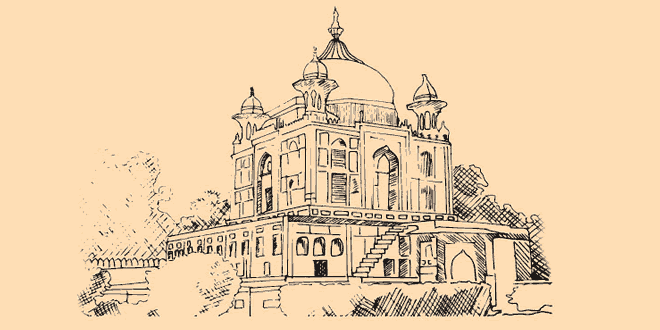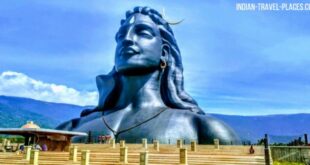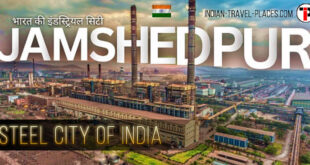| Name: | Allahabad (officially known as Prayagraj) also known as Ilahabad |
| Location: | Allahabad district, Uttar Pradesh, India |
| Climate: | Summers: 450 C (Max), 400 C (Min) | Winters: 220 C (Max), 100 C (Min) |
| Best Time to Visit: | October to March |
| Nearest Airport: | Allahabad Airport, officially known as Prayagraj Airport (12 km from Allahabad city and serves domestic flights) |
| Railway Station: | Prayag, Allahabad City (Rambagh), Daraganj, Allahabad Junction |
| Must Visits: | Triveni Sangam, Company Bagh, Alfred Park, Allahabad Museum, Ewing Christian College, Nagvasuki Temple, Someshwar Mahadev Temple, Khusro Bagh |
| Language Spoken: | Hindi, Urdu |
| STD Code: | 0532 |
Allahabad is one the most sacred cities of India. Located in the heart of northern state of Uttar Pradesh, it is believed to be the second oldest city of India and falls under the administrative district of Allahabad. The city is spread over an area of 113 square kilometers at an elevation of 98 m above the sea level. Similar to the other northern cities of India, the climate of this city can be classified as humid subtropical climate with extremely hot and dry summers (April-June), cool winters (December to February) and warm humid monsoon (July-September). These extreme weather conditions make the time period of October to March, the best time to visit the city of Allahabad. This city is famous for being situated at Triveni Sangam, the convergence of the holy rivers Ganges and Yamuna, and the ancient Sarasvati River. Also, it is known worldwide for the Kumbh Mela of Prayag which occurs once in 12 years.
The ancient name of Allahabad was Prayag (place of sacrifice), as it is believed to be the place where Brahma offered His first sacrifice, after creating the world. This holy city’s existence can be seen while recalling the history of ancient empires like Maurya, Gupta, Kushan Empire and Kannauj Empire. Later, it became the part of Mughal Empire in 1526, during which its name was changed from Prayag to Allahabad meaning “the city of Allah”. After the rule of the Mughals, Allahabad was invaded by the Marathas. However in the year 1765, it came under the rule of British Empire which lasted till a long time. Apart from its religious and mythological worth, the city holds a huge impact during the struggle for Independence of India. In fact, many historical events which changed the face of struggle happened here only.
Allahabad University, founded in 1887, is the fourth oldest sustaining university of India. The city also serves as the home for Prayag Sangeet Samiti which offers an education in Hindustani classical music. As the city is a potential pilgrimage centre for devotees and visitors, it has a well developed transport system which links it to the outer world. Other than, Triveni Sangam and Kumbh Mela, Allahabad has a plethora of various historical and architectural spots where one can confront the glorious past. Anand Bhavan and Jawahar Planetarium, Company Bagh, Alfred Park, Allahabad Museum, Ewing Christian College, Nagvasuki Temple, Someshwar Mahadev Temple, Khusro Bagh and Allahabad Fort (Fort of Akbar) are few of them. For those visiting Allahabad, don’t forget to take a holy dip in Sangam; it is said to sanctify people from all their sins.
Best Time To Visit Allahabad
An abode to the revered saints and many distinguished leaders of the country, Allahabad is a confluence of spiritualism, history and heritage. The place has many layers to it that brings out the diverse characteristics of the city. Allahabad is not just renowned for its beautiful temples, but is also touted as the spiritual headquarter for the Hindus. Renowned for its many universities and educational institutions that have shaped the futures of India’s many eminent political leaders, Allahabad University is fondly dubbed as ‘Oxford of India’ too. Besides this, Allahabad has a striking history with the Mughals, the Marathas and even the British East India Company leaving an indelible impression on its face. Even today, you will find several monuments that will remind you of its past trials, tribulations and triumphs. The All Saints Cathedral, Muir College, University Science Faculty, Khusro Bagh, Allahabad High Court are some of the striking examples of British and Mughal former influence in the city. Allahabad is usually avoided by the tourists during the summer season. To know more on the best time to visit Allahabad, scroll down the write up below.
When To Go To Allahabad
Weather
Allahabad is endowed with a humid subtropical climate. With three major climates to its name, comprising of singeing summers, arid winters and swampy monsoons, the city goes through drastic weather changes throughout the year. Summer, in this religious capital, begins during the end week of March and lasts until June. Temperatures during this season usually range between 400 C to 450 C. Monsoon hits the city during July and lasts until September. During the rainy days, Allahabad is flooded with rain water. Winters begin in December and lasts until February with temperatures dipping down as low as 100 C.
Opting For Your Favorite Season
The sun-kissed ghats during the summers makes for a spectacular sight with scores of saffron clad ‘sadhus’ flocking in huge numbers to perform their ritual ablution. At noon time, half of the city’s population is out on the ghats, from adults to children, taking a dip in the scared Ganges. Summers are a great time to soak in the warm waters and enjoy the local sights. The best time to visit Allahabad in summer is during the month of March as the heat is tolerable during this time. Monsoon is a relief to the local people. With the burst of clouds, the atmosphere in the city is ecstatic with happy people celebrating and enjoying the soothing earthy smell of the rains. The month between June to September are the best time to be in Allahabad, if you enjoy monsoon showers. Winters in the city is no less than hill-station with temperatures dropping down as low as 090 C. Early winter mornings are a great time to explore the mysticism of the city along with its grand ancient history.
Best Time To Visit Allahabad
The best time to visit Allahabad is between December and March when the mellow sun tots up as a pure delight for the senses. Rise to the early views of dawn with the sun and the mist playing hide and seek. Mid-day in the city settles down to a pleasant temperature – a perfect time for a jaunt. Apart from its wonderful climate, another reason to be in the city during winter is to witness the Kumbh Mela. The Kumbh Mela takes place every year during January and lasts until mid February and is the most auspicious festival in the region. During the festivity, Allahabad is a mesmerizing sight, with an army of saints clad in saffron robes waving religious flags and marching towards the Ganges. Another important festival here is the Makar Sankranti, which is another important celebration in the city.
History Of Allahabad
Also known as ‘Prayag’, meaning ‘place of sacrifices’, Allahabad is one of India’s oldest cities. It is said that Brahma offered his first sacrifice in this place, which earned the city its former name. During the rule of the Hindu kingdom in India, Prayag formed an important part of the Vatsa, Mauryan, Gupta, Kushan and Kannauj dynasty. After the incursion of the Mughal dynasty, the Muslim leaders realized the significance of its strategic military position. During the peak of the Maratha rule, the city witnessed many raids and invasions. In the 18th century, with the dominance of the British Raj in India, the political leaders of Allahabad actively participated in the Indian Mutiny. The city was also a favorite convention place for the Indian National Congress from 1888 to 1892. During the period of the Indian freedom struggle, Allahabad became the hub for most political activities such as satayagraha and other freedom movements in India. Read through the write-up to know more about Allahabad’s trials, tribulations and triumphs.
Allahabad History
Allahabad During The Ancient Period
Formerly known as ‘Prayag’, the ancient city of Allahabad has been cited in Vedas and Puranas, which confirms its pre-historic roots. Archaeological excavations have confirmed the pre-historic existence of the city during the Iron Age. Not only that, this antediluvian city has been depicted in the Indian epic story of Ramayana as well. According to the epic, this hallowed city was once home to several sages and served as a refuge for Lord Rama too. During the medieval times, the town was predominated by numerous Hindu dynasties including the Vatsas, Mauryans, Guptas, Kushans and Kannauj.
Muslim Dominance
The town was first captured by Muhammad Ghori in 1193. The invasion of the Mughal Empire in 1526 again brought the city under Muslim dominance. Akbar realized the military significance of the Doab region and constructed a huge citadel on the banks of the River Sangam and renamed the place as ‘Illahabad’. The fort remained a military garrison until colonial invasion. In the year 1602, Prince Salim (Akbar’s son) rebelled against his father by holding an imperial court in Allahabad, disregarding the royal call to proceed to Agra. After the death of his father in 1605, Salim went on to rule the country from Agra. During the 17th century, Allahabad saw the rising power of the Maratha Empire and the decline of Mughal power over the land.
Colonial Rule
When the British invaded the region, despite the united forces of the Nawab of Awadh and Emperor Shah Alam II, the Muslim kings lost the Battle of Buxar to the English in the year 1765. Though the British officially conquered the region, they did not assume all governing rights but instead only retained their armed forces in the fort. A few years later, the then governor Warren Hastings claimed the province from the reigning emperor only to give it to the Nawab of Awadh. In 1801, the Nawab relinquished the place to the British Company. Very soon, the surrounding areas of Doab, Ajmer and Mewar fell under the control of the East Indian Company. In 1834, Allahabad became the political seat for the northern region. During this time, a High court was also established here, but was later shifted back to Agra. In 1877, the English merged Awadh and Agar as a new state and named it United Provinces of Agra and Oudh, while Allahabad remained as the capital of this state till 1920.
Allahabad During Freedom Struggle
During the Indian Mutiny in 1857, Allahabad played an important role. The British had a very small number of military forces in the town. Maulvi Liaquat Ali, the leader of the Indian rebel group, took benefit of this situation. Once the British suppressed the Indian Mutiny, they established a Police headquarters and Public service commission in the city. Allahabad became the administrative head in this region. Meanwhile, in between 1888 to 1892, the grounds of Darbhanga Castle became an important meeting point for the Indian National Congress. At this point, the city gave birth to several revolutionaries. It was in the year 1920 when Mahatma Gandhi first launched the Quit India Movement from Allahabad. In 1931, the leaders of the Indian Congress frequently met at Anand Bhavan, the family home of Nehru. Many of India’s prominent leaders like Jawaharlal Nehru, Mangla Prasad, Muzaffar Hasan, K. N. Katju, and Lal Bahadur Shastri hailed from this city.
Post-Independence
After Independence, Jawaharlal Nehru was elected as India’s first Prime Minister in the year 1947 and continued to serve the post until the year 1964. With the state reorganizing act passed in the year 1956, just like the changes in the boundaries of other different states, Allahabad also saw modifications with respect to its territories. The city fell under the Uttar Pradesh state and continues to remain an integral part of the state to this day.
How To Reach Allahabad
Allahabad, the most hallowed destination in the country, attracts scores of visitors each day. While a few visitors hit the holy land to find out what the divine place is all about, there are others who come all the way from Singapore, Dubai and other foreign places just to take a dip in the holy confluence and absolve themselves of all sins. Traveling to Allahabad is hardly bothersome since there are a wide range of transportation facilities available for the tourist’s convenience. To unravel the unseen and sample the real flavor of Allahabad, hire a tempo or a cycle rickshaw and wheel down the narrow city lanes. As the vehicle traverses down the streets, make a stopover at the main market areas of Katra, Civil Lines and Chowk and splurge on intriguing souvenirs. So, if you have just made up your mind to tour Allahabad, then gathering information about the transportation modes available to reach the place is beneficial. To know more on how to reach Allahabad, go through the following article.
Traveling To Allahabad
By Air
Allahabad, the pilgrim city of India, has an airport of its own that connects to only a few cities of Kolkata, Delhi and Lucknow. So, the only option left for travelers is to avail the nearest airports of Babatpur Airport (Varanasi), Amausi Airport (Lucknow) and Chakeri Airport (Kanpur). Once you reach any of these airports, you can hire private taxis or cabs to reach your destination.
By Rail
The city is linked to major metropolitan cities of Delhi, Jaipur, Kolkata, Lucknow and Mumbai by rail. Allahabad has four excellent railway stations – Prayag Station, City Station at Rambagh, Daraganj Station and Allahabad Station, which in turn are connected to all the major railway heads in the country. While from Bangalore, there is Bagmati and Sanghmitra Express plying at regular intervals to Allahabad junction, from Mumbai there is Mahanagari Express and Kolkata Mail that operates on all days.
By Road
Since Allahabad is blessed with excellent road network and highways, traveling to this place by road is very inconvenient. There are many private and government buses that ply to Allahabad from many metro cities. If you enter inside this city, you can find three important bus stands, namely Civil Lines on MG Marg, Zero Road and Leader Road. The buses that operate from these bus stands travel to important destinations like Kanpur, Varanasi, Gorakhpur, Lucknow, Delhi and Agra.
Local Transportation
There is no dearth of local transportation within the city. There are several local buses, tourist taxis, auto rickshaws and even cycle-rickshaws that would take you anywhere within the city for a nominal fee. The drivers might charge more especially to tourists, so it’s always better to bargain before you get yourself a seat. Traveling by tempos is another good and the cheapest option. Hire the tempos from busy areas like Kareli, Kutchery, Rambagh, Naini, Teliyarganj, Jhansi, and Civil Lines. Tourists who are put up in the city hotels can rent cars through local tour operators or from the hotel staffs who are ever ready to arrange the tours.
Places To See In Allahabad
Call it the ‘King of Pilgrimages’ or the ‘Land of Kumbh Mela’, the hallowed city of Allahabad is more than just a spiritual destination. Agreed, Allahabad is the ultimate stop for spiritual seekers in quest of divine grace. Erstwhile known as Prayag, Allahabad, the seat of salvation, isn’t just about confluence of three sanctified rivers but confluence of various faiths. Home to ascetics, sages, pilgrims and devout, this sanctified city holds distinction for being the intellectual hub of India. The antediluvian city of Allahabad hosts an array of historical and educational attractions that makes for a spectacular sight. From museums to mausoleums to rambling ramparts, the architectural delights of this city are truly impeccable. Adding to this are its local culture, unique literature, luscious cuisine, and incredible people of the land. If you wish to unearth all about Allahabad and its major tourist attractions, then trail the following write-up for further information.
Tourist Attractions In Allahabad
Sangam
When travelling to Allahabad, you simply cannot return without taking a dip in the holy confluence, better known to the world as ‘sangam’. The conflux of three major rivers – the Ganges, the Yamuna and the mythical Saraswati, the ‘Triveni Sangam’ serves as the backdrop of the country’s biggest fests, Kumbh Mela and Ardh Kumbh that draws devout Hindus by scores. As per the myths, during the ‘churning of the ocean of milk’ (samudra manthan), a few drops of the holy nectar (amrit) spilled into the water here, thereby bestowing it with a sacred status among the Hindus. During the months of January and February, zillions of sages, ascetics, pilgrims and tourists flock this site to take a holy dip at the sangam and purge themselves of all sins.
Allahabad Fort
For every wanderlust smitten by the travel bug, a trip to the city’s oldest citadel is highly recommended. Posited on the northern banks of River Yamuna, this massive, old garrison constructed by Mughal Emperor Akbar, is truly exemplary in terms of its size, structure and architecture. Flanked by huge walls, lofty towers and three enormous gateways, the Allahabad Fort remains unparalleled in its craftsmanship and grandiosity to this day. However, before you visit this place, make sure to obtain prior permission from military authorities, who presently occupy this fort.
Khusro Bagh
True to its name, this age-old park is dedicated to Prince Khusrau, the elder brother of Mughal Emperor Shah Jahan. This was the place where the elder son of Jahangir was put to rest. Apart from Prince Khusrau’s tomb, this park also houses the tombs of Khusrau’s mother, Shah Begum and his sister, Sultan Nithar Begum. These sandstone mausoleums, flanked by extensive garden, serve as a striking specimen of Mughal architecture.
Allahabad Museum
A visit to any city is incomplete without acquainting oneself to the history, art, culture and customs of the city. To get a real taste of Allahabad, visit the state museum that houses an amazing collection of stone and terracotta sculptures. What’s more, this depository also houses an art gallery that displays Rajasthani miniature images and paintings by Jamini Roy and Nicholas Roerich as well as a rich collection of rare photographs and historical documents. The museum remains open on all days except on Mondays and government holidays. So schedule your visit accordingly.
Anand Bhawan
The ancestral home to India’s most noted political families, the Nehru and the Gandhi and the birthplace of India’s first women Prime Minister, Indira Gandhi, today this large mansion serves as an important memorial in the state. If you are intrigued by the history of Indian freedom struggle and wish to unearth a few facts on the freedom revolution that shook the nation, then a visit to this place will leave you enlightened on the life of the Nehru’s and the Gandhi’s.
Shopping In Allahabad
Home to Allahabad University and eminent dignitaries like Harivansh Rai Bachchan, Hariprasad Chaurasia, V.P Singh and Amitabh Bachchan, the consecrated city of Allahabad charms its tourists with its antediluvian charm and ostentatious religious fairs and festivals. Serving as the epicenter for the holy confluence of Ganga, Yamuna and Saraswati, the city is indeed one of the major pilgrimages in India. Apart from its intriguing history and mind-boggling literature, the place has enough to offer to the shopaholics as well. From an amazing assortment of religious paraphernalia like brass idols, vermillion and prayer books to fresh, seedless guavas and local literature, shopping in Allahabad indeed has its own charms. Adding to the picturesque beauty of the place, the shopping markets here entices you to loosen your purse strings and splurge. From traditional bazaar to modern shopping malls, Allahabad offers everything to suit your taste and pocket. To know more about shopping places in Allahabad, go through the write-up below.
Things To Buy In Allahabad
Religious Paraphernalia
Allahabad is the best place to stop over and pick up religious stuffs like incense sticks, idols of gods and goddesses, camphor, vermilion, books based on mythological stories and many more. Since the city is an important holy town of India, most of the market streets and shops sell religious paraphernalia. Sangam, located 7 km off Civil Lines, is one of the wonderful places not just to take a holy dip in the water, but also grab some interesting spiritual curios.
Books
For book lovers, Allahabad is a paradise since there are many reputed book stores stored with umpteen numbers of valuable books. Wheeler’s Bookshop nestled in MG Marg, Civil Lines has an enviable collection of Bengali fictions, English novels, Hindi story books, etc. Similarly, Allahabad Book Centre on MG Marg and Universal Book Centre in Civil Lines, Bharat Book Depot on Vivekananda Marg are other good alternatives.
Jewellery
Exquisite jewellery in attractive designs and shapes are found in plenty in the markets of Chowk and Civil Lines. Some of the famous places where you can pick up necklaces and other jewellery items are Chaddha Jewelers near Tulsiyani Plaza, Rana Jewellers near Palace Cinema Chauraha and Dulhan Jewellers, Nehru Complex, Chowk.
Namkeens
Namkeen, the mouth-watering fried crispy snack is found in abundance in this holy city. Some of the popular items that sell like hot cakes over here are bhujia, gahtiya, chat papri, saigo, gazak, etc. You can check out popular shops like New Green Sweet House, Sulaki’s, Chandra Sweets, Chhappan Bhog, Netram Moolchand Agarwal among others.
Handicrafts And Antiques
Exotic looking brassware, rare artifacts and antique pieces are few souvenirs which entices you to buy them immediately. Allahabad has a handful of good handicraft shops such as Asian Crafts (Katra Road), Bhuali Crafts (ADA Colony), Rainbow International (George Town) that houses lovely artworks. So, take your time off and hit the above places to stuff your travel bags with memorable souvenirs.
 ITP Indian Travel Places: Food, Travel, Tourism Business Events and Trade Shows
ITP Indian Travel Places: Food, Travel, Tourism Business Events and Trade Shows







